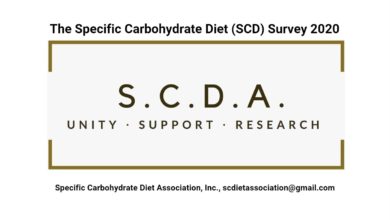什么是SCD疗法
SCD简介
特殊碳水化合物饮食(SCD)是一种限制饮食方式,饮食不含谷物,不含淀粉,无糖,避免大多数乳制品(发酵24小时以上的自制酸奶除外)。SCD注重天然饮食 。富含营养的食物,包括蔬菜,低糖水果,鸡蛋,肉和坚果。本质上,特殊的碳水化合物饮食与我们祖先所吃的非常相似。
历史
SCD的起源可以追溯到一百多年以前,当早期的乳糜泻研究人员认识到他们的患者从饮食中排除谷物时,病情会好转。当时,所有淀粉(不仅是“面筋”)都被挑选出来。在1920年代后期,纽约的儿科医生西德尼·哈斯(Sidney Hass)博士对研究结果进行了研究,并尝试了饮食疗法来治疗年轻患者。通过简单地排除特定碳水化合物,哈斯声称可以治愈儿童腹腔疾病和其他肠道疾病,例如炎症性肠病。
在1950年代,哈斯(Haas)给一个名叫朱迪·戈特绍(Judy Gottschall)的年轻女孩治病,他患有严重的溃疡性结肠炎。朱迪从加州大学(UC)稳定康复后,她的母亲伊莱恩·戈特绍尔(Elaine Gottschall)回到了学校,全心投入研究饮食和食物对肠道的影响。她在47岁时获得了生物学,营养生物化学和细胞生物学学位。1987年,她出版了《食物与内脏反应》(Food and the Gut Reaction),并于1994年作为SCD的权威文章《打破恶性循环-通过饮食使肠道健康》(Breaking the Vicious Cycle – Intestinal health through diet)重新出版。
SCD的拥护者迅速跟随她的脚步,传播着SCD的成功;创建食谱和食谱网站,使他人受益。Gottschall的书和正在进行的研究继续激发着人们进行炎症性肠病,腹腔疾病和其他胃肠道疾病的饮食管理。
SCD饮食的原理
食物按其化学结构分类-单糖,二糖或多糖。在饮食上,仅允许食用含有单糖的碳水化合物。二糖包括乳糖,蔗糖,麦芽糖,异麦芽糖和白糖排除在外不能食用。多糖存在于谷物,淀粉和淀粉类蔬菜中。以下是原文:
这些允许的碳水化合物是单糖,并具有单分子结构,使它们易于被肠壁吸收。不允许使用双糖(双分子)和多糖(链分子)的“复杂碳水化合物”。不容易消化的复杂碳水化合物会在我们的肠子中喂养有害细菌,导致它们过度生长,产生副产物并使肠壁发炎。饮食可以使这些细菌饥饿并恢复肠道内细菌的平衡。”
并非每个人的消化道都进化到可以最佳地消化某些现代食物来源。因此,当这些人从饮食中删除我们饮食中发现的复杂碳水化合物,精制糖和其他合成成分时,消化过程就会改善,毒素减少,炎症消退,整体健康状况也会得到改善。
SCD和肠道微生物
许多消化系统疾病源于“肠道菌群的过度生长和失衡”。换句话说,肠道内存在着太多有害类型的细菌,酵母和真菌。Elaine Gottschall解释说,
“当碳水化合物没有被完全消化和吸收时,它们就会留在我们的肠道中,并成为我们所饲养的微生物的营养。微生物本身必须消化这些未使用的碳水化合物,并且它们通过发酵过程进行消化。发酵的废物是甲烷,二氧化碳和氢气等气体,以及乳酸和乙酸以及毒素,所有这些气体都会刺激和损害肠道。”
但是,SCD饮食中允许的食物很容易被人体消化吸收,几乎不留任何有害细菌。
“由于缺乏食物,微生物数量减少,其有害副产品也减少,使肠道表面的有害物质得以释放,吸收不良被逆转。这样身体可以正常吸收能量和营养,人体中的所有细胞都可以正常吸收。营养丰富,包括免疫系统的细胞,然后可以帮助克服有害微生物的入侵。”
这样,SCD既可以解决导致严重疾病的消化道问题,又可以解决与炎症,细菌过度生长和营养吸收不良有关的症状。
谁可以从SCD中受益
SCD最常推荐给患有乳糜泻,炎性肠病(例如克罗恩氏病,溃疡性结肠炎)和憩室炎的人。如果您没有可诊断的消化系统疾病,但患有持续性肠易激综合症症状(如便秘,腹泻,气体,腹胀)或食物过敏,SCD饮食也可以提供帮助。简单地去除难以消化的碳水化合物将有助于降低肠道内的细菌发酵导致的毒素增加,从而导致这些症状。反过来,饮食将有助于防止肠道渗透性(渗漏性肠道),这可能会导致更严重的健康问题。最近,甚至有人建议SCD可以帮助自闭症等学习障碍
为避免争议,以下是翻译的原文
A BEGINNERS GUIDE TO SCD
The specific carbohydrate diet (SCD) is an elimination diet that is grain free, starch free, sugar free and avoids most dairy (except for hard, aged cheese and homemade yogurt that has been fermented for over 24 hours.) The SCD focuses on natural, nutrient rich foods that includes vegetables, low-sugar fruits, eggs, meats and nuts. Essentially, the specific carbohydrate diet is very similar to what our ancestors ate.
THE HISTORY
The origins of the SCD can be traced back over a hundred years when early Coeliac disease researchers recognised that their patients did better when they removed grains from their diet. At the time, all starches (not just ‘gluten’) were singled out. In the late 1920’s, Dr. Sidney Hass, a paediatrician in New York, took the findings and experimented with diet as a therapy for his young patients. By simply excluding specific carbohydrates, Haas claimed to cure children of Coeliac disease and other gut conditions, such as inflammatory bowel disease.
In the 1950’s, Haas was treating a young girl by the name of Judy Gottschall, who was very sick with Ulcerative Colitis. After Judy’s steady recovery from UC, her mother, Elaine Gottschall, returned to study so that she could dedicated her life to researching the diet and the effects of food on the gut. At 47 she had earned degrees in biology, nutritional biochemistry, and cellular biology. In 1987, she published ‘Food and the Gut Reaction’, which was republished in 1994 as definitive SCD text “Breaking the Vicious Cycle – Intestinal health through diet”.
Advocates of the SCD quickly followed in her footsteps to spread the word of its efficacy; creating cookbooks and recipe websites for others to benefit from. Gottschall’s book and ongoing research continues to inspire people in the dietary management of inflammatory bowel disease, Coeliac disease and other gastrointestinal diseases.
DIET WORKS
Foods on the SCD are classified by their chemical structure – either monosaccharide, disaccharide, or polysaccharide. On the diet, only monosaccharide carbohydrates are permitted. Disaccharides include lactose, sucrose, maltose, and isomaltose and white sugar. Polysaccharides and are found in grains, starches and starchy veggies.
“These allowed carbohydrates are monosaccharides and have a single molecule structure that allow them to be easily absorbed by the intestine wall. ‘Complex carbohydrates’ which are disaccharides (double molecules) and polysaccharides (chain molecules) are not allowed. Complex carbohydrates that are not easily digested, feed harmful bacteria in our intestines causing them to overgrow producing by-products and inflaming the intestine wall. The diet works by starving out these bacteria and restoring the balance of bacteria in our gut.”
Not everyone’s digestive tract has evolved to optimally digest some modern food sources. So when complex carbohydrates, refined sugar and other synthetic ingredients found in our diet are removed from the diet of these people, digestive processes improve, toxins are reduced, inflammation subsides and overall health improves.
SCD AND THE MICROBIOME
The rationale behind the SCD diet is that many digestive disorders stem from “an overgrowth and imbalance of intestinal microbial flora”. In other words, there are too many harmful types of bacteria, yeast and fungus residing within the body (mostly within the gut) where the majority of the immune system is located. Elaine Gottschall explains,
“When carbohydrates are not fully digested and absorbed, they remain in our gut, and become nutrition for the microbes we host. The microbes themselves must digest these unused carbohydrates, and they do this through the process of fermentation. The waste products of fermentation are gases, such as methane, carbon dioxide & hydrogen, and both lactic & acetic acids, as well as toxins and all serve to irritate and damage the gut.”
Foods allowed on the diet are easily digested and absorbed by the body and leave little behind for bad bacteria to enjoy.
“As the microbial population decreases due to lack of food, its harmful by-products also decrease, freeing the intestinal surface of injurious substances. Malabsorption is replaced by absorption. As the individual absorbs energy and nutrients, all the cells in the body are properly nourished, including the cells of the immune system, which then can assist in overcoming the microbial invasion.”
In this way, the SCD targets both the underlying problems within the digestive tract that can lead to serious disorders as well as symptoms related to inflammation, bacterial overgrowth and poor nutrient absorption.
BENEFIT FROM THE SCD
The SCD is most often recommended to people with Coeliac disease, inflammatory bowel diseases (such as Crohns disease, ulcerative colitis) and diverticulitis. If you don’t have a diagnosable digestive disorder but suffer from persistent irritable bowel syndrome symptoms (like constipation, diarrhoea, gas, bloating) or food sensitivities, the SCD diet can also help. Simply removing hard to digest carbohydrates will help lower fermentation in the gut which leads to these symptoms. In turn, the diet will help prevent gut permeability (leaky gut) which could lead to more serious health issues down the track. More recently, it’s even been suggested that the SCD can help with learning disabilities such as autism.





